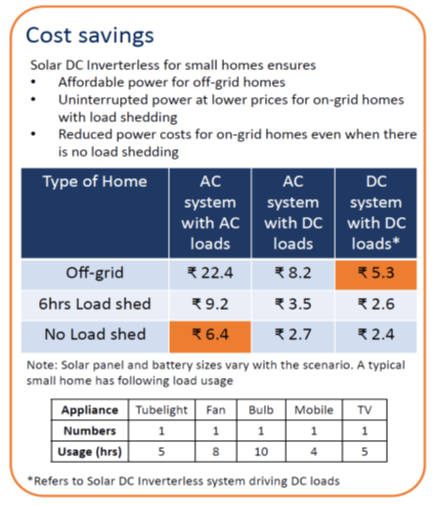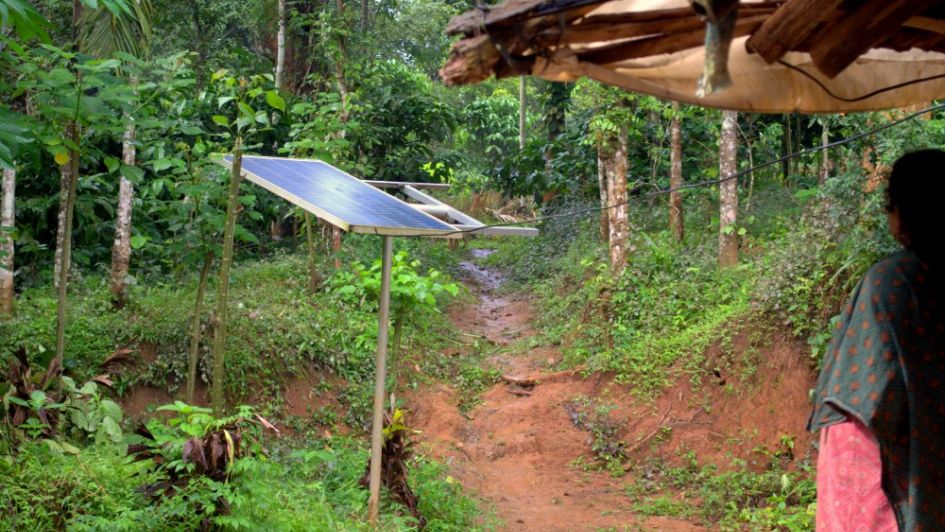In an attempt to address electricity poverty in India and make uninterrupted power accessible to all, the Indian Institute of Technology (IIT) Madras, in conjunction with several utilities, has pioneered work on solar-powered direct-current (DC) micro-grids that have reduced system costs by about 50%. The project has so far connected around 9,000 homes in 11 states.
The idea is simple. Have an internal distribution line with DC appliances running on DC power, and utilize solar panels and batteries which are inherently DC. Since this marries the energy-efficient DC technology with solar power solution, the size of the system falls drastically.
For homes not connected to the grid, a 125-watt micro-grid with a solar panel backed up by a small battery can supply daily power needs. For connected households, the micro-grid acts as a backup power supply to let lighting, fans, TV sets, and cellphone chargers continue operating even during brownouts.
Solar DC power generation is a disruptive concept which challenges the current business model of generation and distribution.

A solar DC inverterless technology solution, which was designed to facilitate full integration with the grid, offers a new market architecture with generation at point-of-use, minimal transmission costs, and storing electricity for later consumption. This translates to energy and cost savings of about 50% compared to conventional solar power solutions available today (see chart at left). The inverterless controller box has a very efficient converter especially designed (but not limited) for low power levels and kicks in only in cases where grid is available.
The largest solar DC inverterless deployment to date involves 71 villages in Rajasthan, where IIT Madras has been working with the utility company Jodhpur Vidyut Vitaran Nigam Limited (JVVNL), the Rural Electrification Corporation, and the Ministry of Power to electrify 4,000 off-grid homes. Overall, IIT Madras IIT is carrying out installations across India and doing it in conjunction with various utilities.
The initiative, spearheaded by IIT Madras’ Prof. Ashok Jhunjhunwala, has proven to be a game-changer for JVVNL, as for the conventional power grid to reach these remote villages, it would require building substations and power lines, a difficult and economically unfeasible proposition given the uneven terrain, long distances, and occasional sere sandstorms. Details of many other solar DC inverterless installations can be found here.
A typical solar DC inverterless system comes with a 125-W solar panel, a specially designed 1-kWh lead-acid battery with an expected life span of 1,600 cycles (compared to about 800 cycles for a normal battery), and an inverterless controller box. This would be enough to power a full-size DC fan, a dimmable LED tube light, an LED lightbulb, and a cellphone charger. The homeowner can add extra lights or a TV set, as long as the overall system sizing is done appropriately.
The entire system’s manufacture and installation costs a fraction of traditional grid electrification.
A grid-connected home where power is unreliable can benefit from having a separate DC line, which provides about 10% of the usual household load during brownouts.
For many rural villages, conventional electrification is many years away, at best. In the meantime, DC appliances will keep getting better. A wider range of products will come to market, including evaporative coolers, small DC refrigerators, and solar stoves. Solar panels, batteries, and other micro-grid components will continue to become cheaper and more efficient. In the end, the villagers may find that their off-grid systems provide all that they need.
A current bottleneck is availability of DC-based appliances like refrigerators and air conditioners, but this is a major international focus and these types of appliances are expected to come to market in the next year or so.
Manufacturing of standard solar components is a small part of a larger emerging industry. Inverterless, application monitoring software, storage systems, domestic and commercial building energy management systems, and smart meters are some of the areas that startups like Cygni Energy, Chakra Networks, Swadha Energy, and Zazen Systems, among others, are working on.
